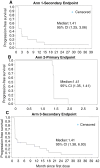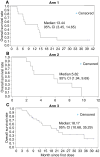Phase II trial of blood-brain barrier permeable peptide-paclitaxel conjugate ANG1005 in patients with recurrent high-grade glioma
- PMID: 39713041
- PMCID: PMC11662161
- DOI: 10.1093/noajnl/vdae186
Phase II trial of blood-brain barrier permeable peptide-paclitaxel conjugate ANG1005 in patients with recurrent high-grade glioma
Abstract
Background: This study is a phase II clinical trial to evaluate the efficacy, safety, and tolerability of the blood-brain barrier (BBB) permeable peptide-paclitaxel conjugate ANG1005 in patients with recurrent high-grade glioma (HGG) (NCT01967810).
Methods: Seventy-three patients were enrolled in 3 separate arms-recurrent glioblastoma (GBM) (Arm 1), bevacizumab refractory GBM (Arm 2), and grade 3 anaplastic gliomas (AGs) (Arm 3). The study was started in October 2013, and the data were locked on September 29, 2017. Safety was evaluated for all three arms (n = 73), and the primary endpoint for Arms 1 and 3 was objective response rate (ORR), and Arm 2 primary endpoint was progression-free survival rate at 3 months (PFS3).
Results: Overall, the safety of ANG1005 was found to be consistent with a taxane toxicity profile. Otherwise, the primary efficacy endpoints of ORR and PFS were not met. The most common adverse events (AEs) were hematologic (32.9%), alopecia (31.5%), and fatigue (30.1%). The median PFS was 1.4 months (95% CI: 1.4, 2.1) and similar across all the treatment arms. The median overall survival was 13.4 months (95% CI: 3.4, 14.6) in Arm 1, 5.8 months (95% CI: 1.9, 9.7) in Arm 2, and 18.2 months (95% CI: 10.7, 35.3) in Arm 3.
Conclusion: A dose of 600 mg/m2 was determined to be safe in this study. However, the primary efficacy endpoint was not met in the NCT01967810-ANG1005 trial, and no further studies are planned in the glioma setting with this compound.
Keywords: ANG1005; high-grade glioma; paclitaxel; phase II clinical trial.
© The Author(s) 2024. Published by Oxford University Press, the Society for Neuro-Oncology and the European Association of Neuro-Oncology.
Conflict of interest statement
P.K. holds ownership interest (including patents) in Angiochem and is an advisory board member/unpaid consultant for Elevate Bio. A.M.S. is a consultant for Carthera and Angiochem. A.M.S. has received in-kind and funding support from Carthera, Agenus, and BMS. J.D. receives research support from Novartis, Servier, Novocure, hemerion is a consultant with Servier, Elsevier, and has stocks with Gilead, Pfizer, GSK, Wolters Kluwer. M.A. is a consultant for Bayer, Novocure, Kiyatec, Insightec, GSK, Xoft, Nuvation, Cellularity, SDP Oncology, Apollomics, Prelude, Janssen, Tocagen, Voyager Therapeutics, Viewray, Caris Lifesciences, Pyramid Biosciences, Varian Medical Systems, Cairn Therapeutics, Anheart Therapeutics, Theraguix, Menarini Ricerche, Sumitomo Pharma Oncology, Autem therapeutics, GT Medical Technologies, Allovir. He is on the scientific advisory board of Cairn Therapeutics, Modifi biosciences. Bugworks and holds stock options with Mimivax, Cytodyn, MedInnovate Advisors LLC, Trisalus Lifesciences. All the other authors declare that they have no competing interests.
Figures




Similar articles
-
Phase II study of panobinostat in combination with bevacizumab for recurrent glioblastoma and anaplastic glioma.Neuro Oncol. 2015 Jun;17(6):862-7. doi: 10.1093/neuonc/nou350. Epub 2015 Jan 7. Neuro Oncol. 2015. PMID: 25572329 Free PMC article. Clinical Trial.
-
Efficacy and safety of nanoparticle albumin-bound paclitaxel plus carboplatin as neoadjuvant chemotherapy for stages III-IV, unresectable ovarian cancer: a single-arm, open-label, phase Ib/II study.BMC Med. 2024 Oct 29;22(1):496. doi: 10.1186/s12916-024-03697-1. BMC Med. 2024. PMID: 39468597 Free PMC article. Clinical Trial.
-
SAKK 24/09: safety and tolerability of bevacizumab plus paclitaxel vs. bevacizumab plus metronomic cyclophosphamide and capecitabine as first-line therapy in patients with HER2-negative advanced stage breast cancer - a multicenter, randomized phase III trial.BMC Cancer. 2016 Oct 10;16(1):780. doi: 10.1186/s12885-016-2823-y. BMC Cancer. 2016. PMID: 27724870 Free PMC article. Clinical Trial.
-
Anti-angiogenic therapy for high-grade glioma.Cochrane Database Syst Rev. 2018 Nov 22;11(11):CD008218. doi: 10.1002/14651858.CD008218.pub4. Cochrane Database Syst Rev. 2018. PMID: 30480778 Free PMC article.
-
External beam radiation dose escalation for high grade glioma.Cochrane Database Syst Rev. 2020 May 21;5(5):CD011475. doi: 10.1002/14651858.CD011475.pub3. Cochrane Database Syst Rev. 2020. PMID: 32437039 Free PMC article.
Cited by
-
Innovative Peptide Therapeutics in the Pipeline: Transforming Cancer Detection and Treatment.Int J Mol Sci. 2025 Jul 16;26(14):6815. doi: 10.3390/ijms26146815. Int J Mol Sci. 2025. PMID: 40725089 Free PMC article. Review.
-
Advances in brain-targeted delivery strategies and natural product-mediated enhancement of blood-brain barrier permeability.J Nanobiotechnology. 2025 May 26;23(1):382. doi: 10.1186/s12951-025-03415-w. J Nanobiotechnology. 2025. PMID: 40420216 Free PMC article. Review.
-
Crossing the Blood-Brain Barrier: Innovations in Receptor- and Transporter-Mediated Transcytosis Strategies.Pharmaceutics. 2025 May 28;17(6):706. doi: 10.3390/pharmaceutics17060706. Pharmaceutics. 2025. PMID: 40574019 Free PMC article. Review.
-
Beyond the Walls of Troy: A Scoping Review on Pharmacological Strategies to Enhance Drug Delivery Across the Blood-Brain Barrier and Blood-Tumor Barrier.Int J Mol Sci. 2025 Jul 22;26(15):7050. doi: 10.3390/ijms26157050. Int J Mol Sci. 2025. PMID: 40806198 Free PMC article. Review.
References
-
- Motl S, Zhuang Y, Waters CM, et al. Pharmacokinetic considerations in the treatment of CNS tumours. Clin Pharmacokinet. 2006; 45(9):871–903. - PubMed
-
- Wen PY, Kesari S.. Malignant gliomas in adults. N Engl J Med. 2008; 359(5):492–507. - PubMed
-
- Stupp R, Mason WP, van den Bent MJ, et al.; European Organisation for Research and Treatment of Cancer Brain Tumor and Radiotherapy Groups. Radiotherapy plus concomitant and adjuvant temozolomide for glioblastoma. N Engl J Med. 2005; 352(10):987–996. - PubMed
Associated data
Grants and funding
LinkOut - more resources
Full Text Sources
Medical
Miscellaneous
